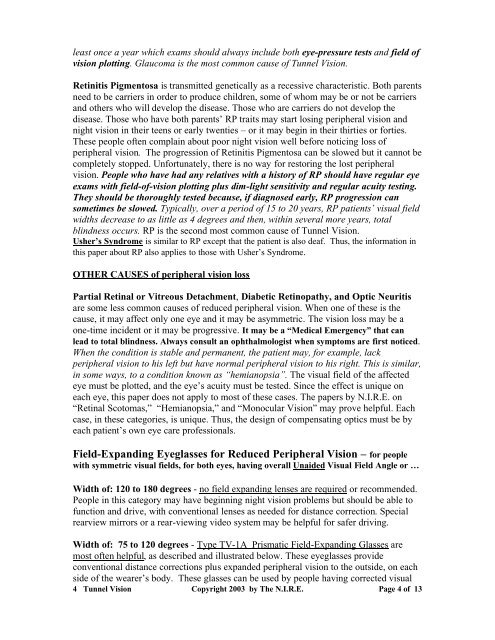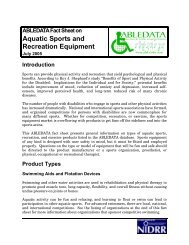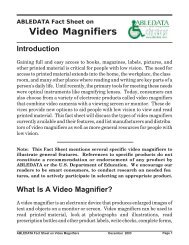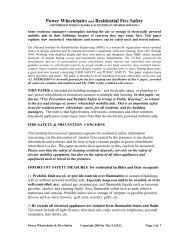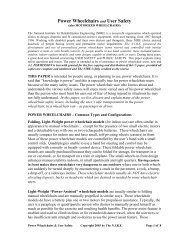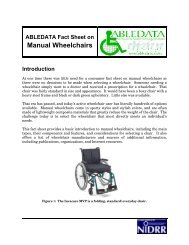Vision Aids for Impaired Peripheral Vision or Tunnel Vision - AbleData
Vision Aids for Impaired Peripheral Vision or Tunnel Vision - AbleData
Vision Aids for Impaired Peripheral Vision or Tunnel Vision - AbleData
You also want an ePaper? Increase the reach of your titles
YUMPU automatically turns print PDFs into web optimized ePapers that Google loves.
least once a year which exams should always include both eye-pressure tests and field of<br />
vision plotting. Glaucoma is the most common cause of <strong>Tunnel</strong> <strong>Vision</strong>.<br />
Retinitis Pigmentosa is transmitted genetically as a recessive characteristic. Both parents<br />
need to be carriers in <strong>or</strong>der to produce children, some of whom may be <strong>or</strong> not be carriers<br />
and others who will develop the disease. Those who are carriers do not develop the<br />
disease. Those who have both parents’ RP traits may start losing peripheral vision and<br />
night vision in their teens <strong>or</strong> early twenties – <strong>or</strong> it may begin in their thirties <strong>or</strong> <strong>f<strong>or</strong></strong>ties.<br />
These people often complain about po<strong>or</strong> night vision well be<strong>f<strong>or</strong></strong>e noticing loss of<br />
peripheral vision. The progression of Retinitis Pigmentosa can be slowed but it cannot be<br />
completely stopped. Un<strong>f<strong>or</strong></strong>tunately, there is no way <strong>f<strong>or</strong></strong> rest<strong>or</strong>ing the lost peripheral<br />
vision. People who have had any relatives with a hist<strong>or</strong>y of RP should have regular eye<br />
exams with field-of-vision plotting plus dim-light sensitivity and regular acuity testing.<br />
They should be th<strong>or</strong>oughly tested because, if diagnosed early, RP progression can<br />
sometimes be slowed. Typically, over a period of 15 to 20 years, RP patients’ visual field<br />
widths decrease to as little as 4 degrees and then, within several m<strong>or</strong>e years, total<br />
blindness occurs. RP is the second most common cause of <strong>Tunnel</strong> <strong>Vision</strong>.<br />
Usher’s Syndrome is similar to RP except that the patient is also deaf. Thus, the in<strong>f<strong>or</strong></strong>mation in<br />
this paper about RP also applies to those with Usher’s Syndrome.<br />
OTHER CAUSES of peripheral vision loss<br />
Partial Retinal <strong>or</strong> Vitreous Detachment, Diabetic Retinopathy, and Optic Neuritis<br />
are some less common causes of reduced peripheral vision. When one of these is the<br />
cause, it may affect only one eye and it may be asymmetric. The vision loss may be a<br />
one-time incident <strong>or</strong> it may be progressive. It may be a “Medical Emergency” that can<br />
lead to total blindness. Always consult an ophthalmologist when symptoms are first noticed.<br />
When the condition is stable and permanent, the patient may, <strong>f<strong>or</strong></strong> example, lack<br />
peripheral vision to his left but have n<strong>or</strong>mal peripheral vision to his right. This is similar,<br />
in some ways, to a condition known as “hemianopsia”. The visual field of the affected<br />
eye must be plotted, and the eye’s acuity must be tested. Since the effect is unique on<br />
each eye, this paper does not apply to most of these cases. The papers by N.I.R.E. on<br />
“Retinal Scotomas,” “Hemianopsia,” and “Monocular <strong>Vision</strong>” may prove helpful. Each<br />
case, in these categ<strong>or</strong>ies, is unique. Thus, the design of compensating optics must be by<br />
each patient’s own eye care professionals.<br />
Field-Expanding Eyeglasses <strong>f<strong>or</strong></strong> Reduced <strong>Peripheral</strong> <strong>Vision</strong> – <strong>f<strong>or</strong></strong> people<br />
with symmetric visual fields, <strong>f<strong>or</strong></strong> both eyes, having overall Unaided Visual Field Angle <strong>or</strong> …<br />
Width of: 120 to 180 degrees - no field expanding lenses are required <strong>or</strong> recommended.<br />
People in this categ<strong>or</strong>y may have beginning night vision problems but should be able to<br />
function and drive, with conventional lenses as needed <strong>f<strong>or</strong></strong> distance c<strong>or</strong>rection. Special<br />
rearview mirr<strong>or</strong>s <strong>or</strong> a rear-viewing video system may be helpful <strong>f<strong>or</strong></strong> safer driving.<br />
Width of: 75 to 120 degrees - Type TV-1A Prismatic Field-Expanding Glasses are<br />
most often helpful, as described and illustrated below. These eyeglasses provide<br />
conventional distance c<strong>or</strong>rections plus expanded peripheral vision to the outside, on each<br />
side of the wearer’s body. These glasses can be used by people having c<strong>or</strong>rected visual<br />
4 <strong>Tunnel</strong> <strong>Vision</strong> Copyright 2003 by The N.I.R.E. Page 4 of 13


